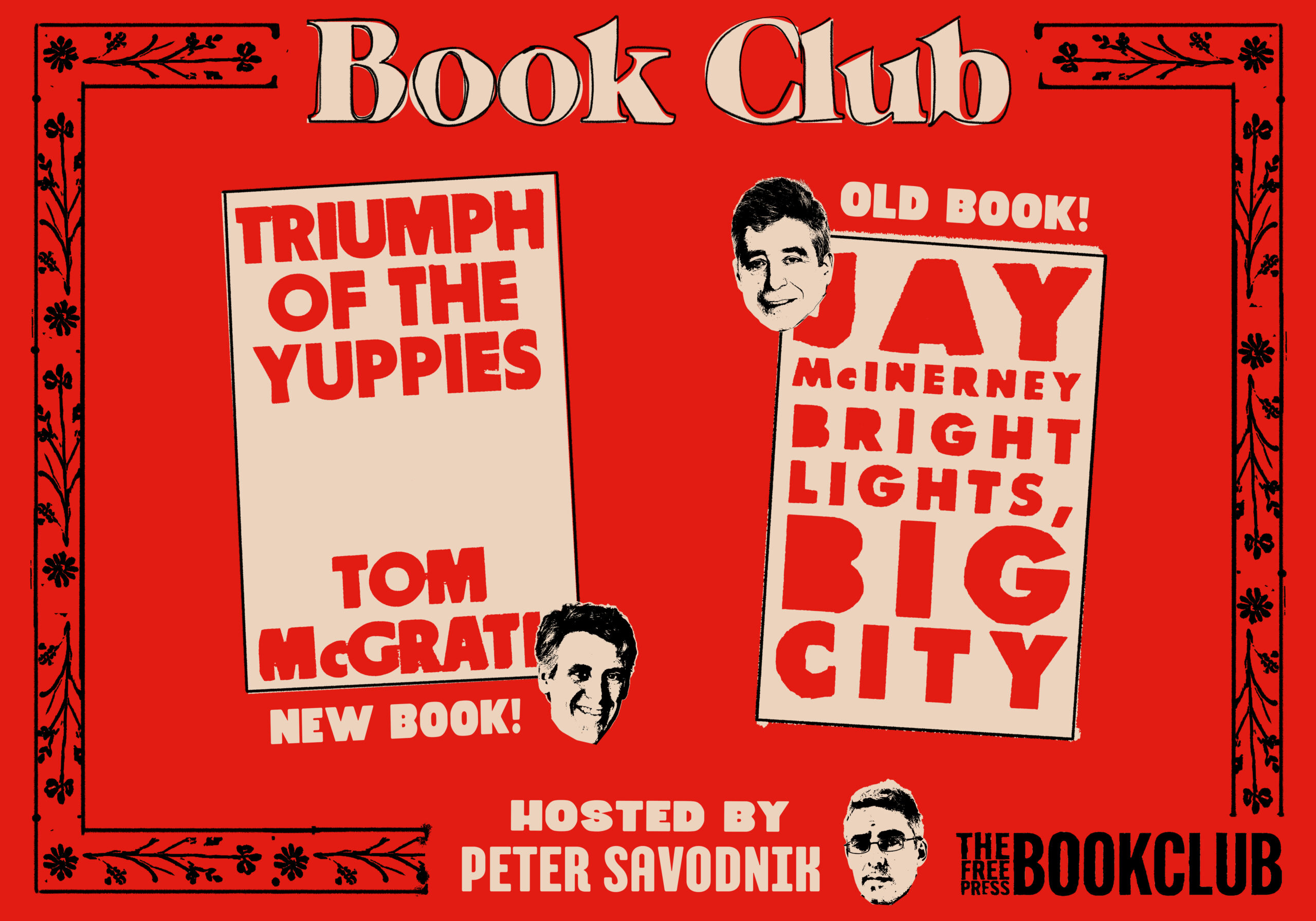Substacks
Diane von Furstenberg Is More Than a Girlboss Suzy Weiss

This piece was first published in our news digest, The Front Page. To get our latest scoops, investigations, and columns in your inbox every morning, Monday through Thursday, become a Free Press subscriber today:
The new Diane von Furstenberg documentary, Diane von Furstenberg: Woman in Charge frames the 77-year-old Belgian designer as the world’s first girlboss: an entrepreneur unafraid to be sexy as she kicked down the doors of the boys’ club in her stilettos.
But while she is, yes, wildly successful and self-possessed, her animating principle isn’t progressivism or gender equality but an endless quest for freedom.
Von Furstenberg sought sexual freedom since she went to boarding school, falling in love with a man and then a woman in quick succession, and then, as she got older, everyone else. She said of leaving Prince Egon von Furstenberg, her first husband with whom she had two kids, “Divorce was freedom.” She described her iconic wrap dress, a form-fitting, printed jersey blockbuster as the “uniform for freedom.” She says of the crowd at Studio 54, “We thought we had invented freedom.”
She even chafes at the title of fashion designer, saying instead, “I had a vocation to be a free woman.”
Von Furstenberg’s obsession with being free is all downstream of the fact that her mother Lily was a prisoner of the Nazis, weighing 49 pounds when she was liberated from Auschwitz. Doctors told Lily it would be impossible to have a child. Soon after, Diane was born in Brussels, with a mission, it seems, to push liberation as far as she could.
Another wrinkle in the plot to make von Furstenberg into a boss babe fighting the patriarchy: she refuses to be a victim.
The director asks if any men made her feel uncomfortable early in her career. “I would never give anyone that much credit,” she says. A New Yorker reporter said that von Furstenberg “didn’t fit the mold” of a second-wave feminist because she “wore fishnet stockings and heels.” He asked von Furstenberg if she felt accepted by that movement, to which she offered, “I don’t know. I never asked them.” He then brings up sex positivity, to which von Furstenberg replies, “What did you say? ‘Sex-positive’? What does that mean?”
And unlike the girlboss of the 2010s, von Furstenberg doesn’t care how her image—which is of a rich, bisexual vixen—is received, or how her politics come off, or what it says about her that she married two fabulously wealthy men (her second husband is Barry Diller) who, we’re meant to understand, are both gay. It didn’t matter, and in the documentary, you see that she loves them both. Fidelity, domesticity, or stability were not the point of her marriages—freedom was—and they both offered her that.
There are drawbacks, though, to being this free. Her daughter describes being neglected while her mother went out on the town every night. She seems alienated from her own feelings, never crying in the movie and remarking flatly while looking at a cattle car, the same kind that would’ve shipped her mother to a concentration camp, “Crazy, huh?” She says she’s not afraid to die, even though she thinks about it “all the time.”
Most of us will never be as free as Diane von Furstenberg, and plenty of us don’t even want that level of freedom. She went the whole way with it, accepting that being free and doing what you want ups the risk of being burned, exposed, and judged. Like that perfect dress, she wears it with pride.
Suzy Weiss is a reporter at The Free Press. Read her piece, “Hurkle-Durkle Is the New Way to Self-Care Ourselves to Death,” and follow her on X @SnoozyWeiss.
Substacks
June 28, 2024 Heather Cox Richardson
Substacks
Book Club: The Triumph of the Yuppies Peter Savodnik

Last month, we launched The Free Press Book Club, in which one of our writers recommends a new book they love along with a classic work from the past echoing its themes.
In May, Nellie Bowles praised P.J. O’Rourke’s Parliament of Whores—and the joys of political satire—and paired it with, what else? Her own book, Morning After the Revolution. (Did we mention it became a New York Times bestseller?)
Today, Free Press columnist Peter Savodnik picks Triumph of the Yuppies by Tom McGrath, who argues that the rise of the “young urban professional” in the ’80s corrupted America for good. Peter is matching this book with the classic Bright Lights, Big City by Jay McInerney, who became the unofficial “spokesman for the yuppies” after publishing his breakout novel in 1984.
Below, you’ll find an essay from Peter about how yuppies came to be such an influential and corrosive force in our culture—ultimately leading to the election (and possible reelection) of Donald Trump. And if you’re a paid subscriber, we have a special treat for you. At the end of this piece, you can watch Peter in conversation with Tom McGrath and Jay McInerney about the legacy of the yuppie. They discuss Boomers, Wall Street, the culture of consumerism, a few questions from Free Press readers, and ultimately, they answer the bigger question: What can yuppies teach us about America today?
If you’re not already a paid subscriber, become one now to join our monthly book club. You can watch Peter’s conversation, comment on this essay, and get invited to future in-person book club events. (More on that later!):
Meanwhile, send us your thoughts about yuppies at books@thefp.com, and consider buying Bright Lights, Big City and Triumph of the Yuppies from the good people at Bookshop, where every purchase through these links earns a commission for The Free Press. Or if you’re an Amazon customer, click here for Tom’s book or here for Jay’s.
And now, here’s Peter on the Triumph of the Yuppies:
My wife and I were at a dinner party a few months ago, in the Hills, in Los Angeles.
Everyone was in their late 40s or early 50s, and there was a weariness that permeated the conversation—no one wanted to talk about the election, or the border, or China, or AI, or the encampments, or even Ozempic (which, I suspect, two or three people there were injecting regularly). Instead, we talked around the news. There was a vague longing for The Great Before. Before the screens, the brands, the narratives, the curators, the audience-builders. Before there was a conspiracy theory, or theories, swirling around literally everything.
The Great Before—“the time before everyone went crazy,” as our host put it—is the quasi-mythological, prelapsarian America we grew up in: the ’80s.
This is the thing you need to bear in mind about the ’80s: the gargantuan, unapologetic success of it all.
It wasn’t just about money. It was about ostentatiousness, and, really, the celebration of ostentatiousness. “Material Girl” was a hit. Family Ties was a hit. Working Girl was a hit, with its famous, wince-inducing line, uttered by Melanie Griffith: “I have a head for a business and a bod for sin—is there anything wrong with that?”
It was also about the American Dream—which had been battered by Vietnam, stagflation, crime, the Soviet invasion of Afghanistan, the Iranian storming of the U.S. embassy—suddenly rising once again. It was morning in America, as Ronald Reagan reminded us, and the problem was not us, but the communists and big government.
The subtext of all this amounted to an updated social Darwinism: our things were a testament to our national superiority, and our duty as Americans was to keep acquiring them. If we didn’t, could we really say we were superior to everyone else?
All of which is to say that it was not a terribly introspective moment.
Had it been more introspective, we might have realized that the rampant materialism of the yuppie led to a division that now threatens to undo our republic.
That is the suggestion of my Free Press Book Club pick today: Tom McGrath’s Triumph of the Yuppies: America, the Eighties, and the Creation of an Unequal Nation. While a lot of people made a great deal of money in the ’80s, McGrath writes that the era also fundamentally changed the country for the worse. And we are still living inside that country—whether we realize it or not.
Specifically, he argues that America, “in its push to revive itself, in its zeal to recapture the dominance and prosperity of the postwar era,” ultimately ended up “elevating self-interest over any sense of the common good.” In short, “the country had created a new economic and social order that wouldn’t easily be undone.”
We all know what the yuppie looks like—he’s the guy in the Hugo Boss power suit with the pocket square, the Rolex, the monogrammed silk suspenders, crushing it with his fellow investment bankers, throwing back gin buck cocktails at the Harvard Club.
But where did this chump, with his unslakable shallowness, come from?
In the late 1970s and early ’80s, immediately prior to the rise of the yuppie, there was—imagine this, young people of 2024!—a great deal of anxiety about the future.
“The economic burden fell particularly hard on the Baby Boom generation, who were twice as likely to be unemployed as their parents had been in the ’50s and who, even if they had jobs, hardly felt like they were getting ahead,” McGrath writes. Adjusted for inflation, he notes, young people’s salaries actually decreased by $300 annually from 1970 to 1980.
This anxiety, he argues, led to a renewed focus on money and ambition and making all the right decisions—about where one went to school, what one majored in, where one moved after college.
Or who one married, according to the yuppies quoted in McGrath’s book.
Like 28-year-old Robert Drumheller, who told Newsweek in 1981, that “it was very important for me to marry a professional person. One of my goals was to have a high standard of living, and with two incomes you get to the easy life much faster.”
All of a sudden, there was a race for jobs and promotions and spouses, and a relatively small number of young people surged ahead. In 1985, the Chicago Tribune estimated there were 4.2 million yuppies, or 5 percent of all Baby Boomers. Everyone else had been left behind. The era of shared, widespread, upward mobility that had characterized the ’50s and ’60s and petered out in the ’70s, was officially over.
Yuppie America, McGrath told me, was “where you really start to see this divide in America along economic and educational lines.”
It was in May 1980 that the journalist Dan Rottenberg, writing in Chicago magazine, coined the term yuppie, McGrath writes.
But it would take a few years before the public really became aware of this phenomenon—and before the phenomenon became aware of itself.
Then, in September 1984, Vintage Books published Jay McInerney’s Bright Lights, Big City, catapulting McInerney—then 29 and living on Manhattan’s Lower East Side—into something of a star.
“I woke up one morning right after the book was published,” McInerney told me, “and it was published to very little fanfare initially, but The Wall Street Journal picked up on it very quickly, and they announced that I was the spokesman for the yuppies, which kind of horrified me.”
Interestingly, the term yuppie never appears in Bright Lights, Big City. In 1983, when he wrote the novel, it was not yet popular; by the time the novel came out, McInerney said, “We were deep in the middle of this thing.”
In Bright Lights, McInerney’s unnamed, second-person protagonist, who inhabits the periphery of the yuppie universe, offers the first vivid account of this emergent, slightly horrifying species.
On the one hand, he is a New Yorker fact-checker and an aspiring novelist who fashions himself a man of letters—definitely not a yuppie. On the other hand, McInerney said, the protagonist’s best friend-slash-coke dealer, Tad Allagash, “has really no values except having more fun than everybody else and looking good while doing it, so there’s no question that I was chronicling that world.”
After Bright Lights, Big City took off—Triumph of the Yuppies notes that it sold 10,000 copies in its first three weeks and New York City bookstores couldn’t keep it in stock—McInerney had to change his phone number.
“People were calling me up to ask me advice on how to get to these various places” that he wrote about in the novel, “including quite a number that I just made up,” McInerney said. “There is no Lizard Lounge, but a lot of people wanted to know what street it was on.”
McInerney told me the new yuppie materialism amounted to “a rejection of parental values”—TV dinners, the suburbs, all the assumptions that had governed postwar, middle-class life.
What distinguished this boom time from previous boom times, McGrath added, was not simply the ferocity with which yuppies went about buying their Porsches and Cuisinarts and Julian Schnabel paintings and pretty much everything at Sharper Image. It was the nature of the materialism itself.
Earlier generations of Americans had subscribed to an “inclusive materialism,” McGrath told me—it was “a keeping up with the Joneses era,” when everyone shopped at Sears. But for yuppies, “it’s more of an exclusive materialism. ‘I’m going to own this thing, because most people do not have it, and it’s a way of setting myself apart, as opposed to a way of being part of the community.’ ”
“A new generation of young professionals wanted something more, something less common. The buzzword that people started using was quality. The things they purchased would be, like the lives they were trying to create for themselves, excellent.”
By 1985, the anti-yuppie backlash had begun. DIE YUPPIE SCUM started to appear on buildings and streetlamps downtown.
Then, on October 19, 1987, the stock market crashed—with the Dow Jones losing nearly 23 percent of its value, or $500 billion, in a single day. The era of the yuppie was apparently dead.
McInerney smirked when I suggested as much. “Yuppie culture is like the undead,” he told me. “It persisted and thrived and metamorphosed.”
In fact, both authors noted that the spirit of the yuppie is now alive and well in the ur-yuppie known as Donald Trump. Ironically, his 2016 election came about, McGrath writes, because “families at the top of the economic pyramid controlled 79 percent of all wealth in America, up from 60 percent in the 1980s.”
By then, the long-percolating anti-yuppie sentiment in blue-collar America had curdled into an angrier anti-elitism.
And the billionaire Donald Trump “somehow persuaded many working-class Americans that he was on their side.”
I loved talking to both of these writers and reading Triumph of the Yuppies and rereading Bright Lights, Big City. If you’d like to learn more about New York in the go-go ’80s, Ivan Boesky, Tad Allagash, the story behind the rise of Madonna, and Bolivian Marching Powder (read the novel, people), scroll down:
To listen to Peter’s discussion with Tom McGrath and Jay McInerney, become a subscriber today. You’ll also be able to continue the conversation in the comments.
Substacks
Book Club: The Triumph of the Yuppies Peter Savodnik
Last month, we launched The Free Press Book Club, in which one of our writers recommends a new book they love along with a classic work from the past echoing its themes.
In May, Nellie Bowles praised P.J. O’Rourke’s Parliament of Whores—and the joys of political satire—and paired it with, what else? Her own book, Morning After the Revolution. (Did we mention it became a New York Times bestseller?)
Today, Free Press columnist Peter Savodnik picks Triumph of the Yuppies by Tom McGrath, who argues that the rise of the “young urban professional” in the ’80s corrupted America for good. Peter is matching this book with the classic Bright Lights, Big City by Jay McInerney, who became the unofficial “spokesman for the yuppies” after publishing his breakout novel in 1984.
Below, you’ll find an essay from Peter about how yuppies came to be such an influential and corrosive force in our culture—ultimately leading to the election (and possible reelection) of Donald Trump. And if you’re a paid subscriber, we have a special treat for you. At the end of this piece, you can watch Peter in conversation with Tom McGrath and Jay McInerney about the legacy of the yuppie. They discuss Boomers, Wall Street, the culture of consumerism, a few questions from Free Press readers, and ultimately, they answer the bigger question: What can yuppies teach us about America today?
If you’re not already a paid subscriber, become one now to join our monthly book club. You can watch Peter’s conversation, comment on this essay, and get invited to future in-person book club events. (More on that later!):
Meanwhile, send us your thoughts about yuppies at books@thefp.com, and consider buying Bright Lights, Big City and Triumph of the Yuppies from the good people at Bookshop, where every purchase through these links earns a commission for The Free Press. Or if you’re an Amazon customer, click here for Tom’s book or here for Jay’s.
And now, here’s Peter on the Triumph of the Yuppies:
My wife and I were at a dinner party a few months ago, in the Hills, in Los Angeles.
Everyone was in their late 40s or early 50s, and there was a weariness that permeated the conversation—no one wanted to talk about the election, or the border, or China, or AI, or the encampments, or even Ozempic (which, I suspect, two or three people there were injecting regularly). Instead, we talked around the news. There was a vague longing for The Great Before. Before the screens, the brands, the narratives, the curators, the audience-builders. Before there was a conspiracy theory, or theories, swirling around literally everything.
The Great Before—“the time before everyone went crazy,” as our host put it—is the quasi-mythological, prelapsarian America we grew up in: the ’80s.
This is the thing you need to bear in mind about the ’80s: the gargantuan, unapologetic success of it all.
It wasn’t just about money. It was about ostentatiousness, and, really, the celebration of ostentatiousness. “Material Girl” was a hit. Family Ties was a hit. Working Girl was a hit, with its famous, wince-inducing line, uttered by Melanie Griffith: “I have a head for a business and a bod for sin—is there anything wrong with that?”
It was also about the American Dream—which had been battered by Vietnam, stagflation, crime, the Soviet invasion of Afghanistan, the Iranian storming of the U.S. embassy—suddenly rising once again. It was morning in America, as Ronald Reagan reminded us, and the problem was not us, but the communists and big government.
The subtext of all this amounted to an updated social Darwinism: our things were a testament to our national superiority, and our duty as Americans was to keep acquiring them. If we didn’t, could we really say we were superior to everyone else?
All of which is to say that it was not a terribly introspective moment.
Had it been more introspective, we might have realized that the rampant materialism of the yuppie led to a division that now threatens to undo our republic.
That is the suggestion of my Free Press Book Club pick today: Tom McGrath’s Triumph of the Yuppies: America, the Eighties, and the Creation of an Unequal Nation. While a lot of people made a great deal of money in the ’80s, McGrath writes that the era also fundamentally changed the country for the worse. And we are still living inside that country—whether we realize it or not.
Specifically, he argues that America, “in its push to revive itself, in its zeal to recapture the dominance and prosperity of the postwar era,” ultimately ended up “elevating self-interest over any sense of the common good.” In short, “the country had created a new economic and social order that wouldn’t easily be undone.”
We all know what the yuppie looks like—he’s the guy in the Hugo Boss power suit with the pocket square, the Rolex, the monogrammed silk suspenders, crushing it with his fellow investment bankers, throwing back gin buck cocktails at the Harvard Club.
But where did this chump, with his unslakable shallowness, come from?
In the late 1970s and early ’80s, immediately prior to the rise of the yuppie, there was—imagine this, young people of 2024!—a great deal of anxiety about the future.
“The economic burden fell particularly hard on the Baby Boom generation, who were twice as likely to be unemployed as their parents had been in the ’50s and who, even if they had jobs, hardly felt like they were getting ahead,” McGrath writes. Adjusted for inflation, he notes, young people’s salaries actually decreased by $300 annually from 1970 to 1980.
This anxiety, he argues, led to a renewed focus on money and ambition and making all the right decisions—about where one went to school, what one majored in, where one moved after college.
Or who one married, according to the yuppies quoted in McGrath’s book.
Like 28-year-old Robert Drumheller, who told Newsweek in 1981, that “it was very important for me to marry a professional person. One of my goals was to have a high standard of living, and with two incomes you get to the easy life much faster.”
All of a sudden, there was a race for jobs and promotions and spouses, and a relatively small number of young people surged ahead. In 1985, the Chicago Tribune estimated there were 4.2 million yuppies, or 5 percent of all Baby Boomers. Everyone else had been left behind. The era of shared, widespread, upward mobility that had characterized the ’50s and ’60s and petered out in the ’70s, was officially over.
Yuppie America, McGrath told me, was “where you really start to see this divide in America along economic and educational lines.”
It was in May 1980 that the journalist Dan Rottenberg, writing in Chicago magazine, coined the term yuppie, McGrath writes.
But it would take a few years before the public really became aware of this phenomenon—and before the phenomenon became aware of itself.
Then, in September 1984, Vintage Books published Jay McInerney’s Bright Lights, Big City, catapulting McInerney—then 29 and living on Manhattan’s Lower East Side—into something of a star.
“I woke up one morning right after the book was published,” McInerney told me, “and it was published to very little fanfare initially, but The Wall Street Journal picked up on it very quickly, and they announced that I was the spokesman for the yuppies, which kind of horrified me.”
Interestingly, the term yuppie never appears in Bright Lights, Big City. In 1983, when he wrote the novel, it was not yet popular; by the time the novel came out, McInerney said, “We were deep in the middle of this thing.”
In Bright Lights, McInerney’s unnamed, second-person protagonist, who inhabits the periphery of the yuppie universe, offers the first vivid account of this emergent, slightly horrifying species.
On the one hand, he is a New Yorker fact-checker and an aspiring novelist who fashions himself a man of letters—definitely not a yuppie. On the other hand, McInerney said, the protagonist’s best friend-slash-coke dealer, Tad Allagash, “has really no values except having more fun than everybody else and looking good while doing it, so there’s no question that I was chronicling that world.”
After Bright Lights, Big City took off—Triumph of the Yuppies notes that it sold 10,000 copies in its first three weeks and New York City bookstores couldn’t keep it in stock—McInerney had to change his phone number.
“People were calling me up to ask me advice on how to get to these various places” that he wrote about in the novel, “including quite a number that I just made up,” McInerney said. “There is no Lizard Lounge, but a lot of people wanted to know what street it was on.”
McInerney told me the new yuppie materialism amounted to “a rejection of parental values”—TV dinners, the suburbs, all the assumptions that had governed postwar, middle-class life.
What distinguished this boom time from previous boom times, McGrath added, was not simply the ferocity with which yuppies went about buying their Porsches and Cuisinarts and Julian Schnabel paintings and pretty much everything at Sharper Image. It was the nature of the materialism itself.
Earlier generations of Americans had subscribed to an “inclusive materialism,” McGrath told me—it was “a keeping up with the Joneses era,” when everyone shopped at Sears. But for yuppies, “it’s more of an exclusive materialism. ‘I’m going to own this thing, because most people do not have it, and it’s a way of setting myself apart, as opposed to a way of being part of the community.’ ”
“A new generation of young professionals wanted something more, something less common. The buzzword that people started using was quality. The things they purchased would be, like the lives they were trying to create for themselves, excellent.”
By 1985, the anti-yuppie backlash had begun. DIE YUPPIE SCUM started to appear on buildings and streetlamps downtown.
Then, on October 19, 1987, the stock market crashed—with the Dow Jones losing nearly 23 percent of its value, or $500 billion, in a single day. The era of the yuppie was apparently dead.
McInerney smirked when I suggested as much. “Yuppie culture is like the undead,” he told me. “It persisted and thrived and metamorphosed.”
In fact, both authors noted that the spirit of the yuppie is now alive and well in the ur-yuppie known as Donald Trump. Ironically, his 2016 election came about, McGrath writes, because “families at the top of the economic pyramid controlled 79 percent of all wealth in America, up from 60 percent in the 1980s.”
By then, the long-percolating anti-yuppie sentiment in blue-collar America had curdled into an angrier anti-elitism.
And the billionaire Donald Trump “somehow persuaded many working-class Americans that he was on their side.”
I loved talking to both of these writers and reading Triumph of the Yuppies and rereading Bright Lights, Big City. If you’d like to learn more about New York in the go-go ’80s, Ivan Boesky, Tad Allagash, the story behind the rise of Madonna, and Bolivian Marching Powder (read the novel, people), scroll down:
To listen to Peter’s discussion with Tom McGrath and Jay McInerney, become a subscriber today. You’ll also be able to continue the conversation in the comments.
-

 Awakening Video10 months ago
Awakening Video10 months agoThis is What Happens When You Try to Report Dirty Cops
-

 Substacks3 months ago
Substacks3 months agoTHE IRON-CLAD PIÑATA Seymour Hersh
-

 Substacks9 months ago
Substacks9 months agoThe Russell Brand Rorschach Test Kathleen Stock
-

 Substacks9 months ago
Substacks9 months agoA real fact-check of Trump’s appearance on Meet the Press Judd Legum
-

 Substacks8 months ago
Substacks8 months agoLetter to the Children of Gaza – Read by Eunice Wong Chris Hedges








